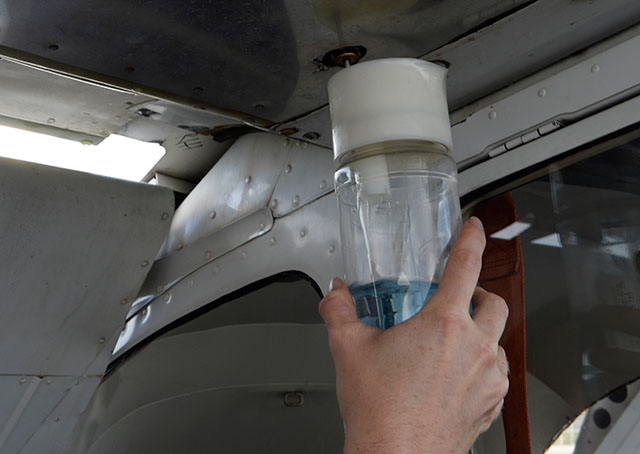
It’s a sight so common at a general aviation airport that it seems as much a part of the scene as the windsock, the aircraft tied down on the ramp, and the fuel trucks coming and going along that line.
Someone is walking around an aircraft, performing a preflight inspection. You can tell at a glance that it is a pilot preparing to fly, and not just an aircraft admirer, because of two things the individual is carrying around: a checklist and a fuel sampling device.
The fuel examination is one of the most important elements of a preflight inspection, and demands careful attention, as has been impressed upon you from the day of your very first preflight inspection. You were taught that fuel is color-coded to help the pilot ascertain that the proper fuel grade for the aircraft is in the tanks. And you’ve learned that condensation of water vapor in partly filled tanks, or rain water leaking into tanks around worn or defective fuel cap seals, is a risk to take into consideration.
Engine-failure accidents linked to misfueling occasionally do occur, and AOPA has joined an industry-wide effort to raise awareness of misfueling. The National Air Transportation Association, assisted by the AOPA Air Safety Institute, recently released its Safety 1st General Aviation Misfueling Prevention Program to help prevent such catastrophic accidents.
It reminds fixed-base operators that fuel nozzles for avgas and Jet A are different sizes. The wide “duck bill”-shaped opening for jet fuel shouldn’t fit the slender fuel-tank openings for 100LL fuel tanks.
Pilots can enhance their well-practiced fuel-examination portion of preflight inspections by making sure their aircraft’s fuel tanks are clearly marked for either Jet A or 100LL, and have the appropriate restrictor installed. (When buying fuel, check your receipt for the type of fuel listed.)
A color check of your fuel may not be enough if, for example, your aircraft had half a tank of 100LL when it was topped off with jet fuel by mistake. But there will be a difference in the fuel sample’s smell—so add that step to your fuel inspection. (An oily odor suggests the presence of jet fuel.)
Ideally, the pilot should supervise the aircraft’s fueling, but that is not always possible. The AOPA Air Safety Institute developed fuel cards that pilots can personalize with information specific to their aircraft if they are not present for refueling. The cards, which can be ordered from Vistaprint, are designed to help pilots, line service personnel, and FBO customer service reps clearly communicate and confirm the fuel order to help prevent misfueling.
The joint Safety 1st effort is the aviation community’s action to combine prevention and heightened emphasis on precautionary measures to promote fuel safety.



